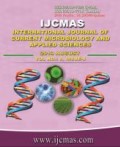


 National Academy of Agricultural Sciences (NAAS)
National Academy of Agricultural Sciences (NAAS)

|
PRINT ISSN : 2319-7692
Online ISSN : 2319-7706 Issues : 12 per year Publisher : Excellent Publishers Email : editorijcmas@gmail.com / submit@ijcmas.com Editor-in-chief: Dr.M.Prakash Index Copernicus ICV 2018: 95.39 NAAS RATING 2020: 5.38 |
Field experiments were conducted in D-2 block of Norman E. Borlaug Crop Research Centre of G.B. Pant University of Agriculture and Technology, Pantnagar, Distt. Udham Singh Nagar (Uttarakhand) during 2017-18 and 2018-19. The objectives of the investigation were to study effect of tillage systems and residue loads on the initial establishment, growth attributes and productivity of wheat. The soil of the experimental plot was clay loam high in organic carbon (0.80%), medium in available nitrogen (246.3 kg/ha), high in available phosphorus (22.7 kg/ha) and medium in available potassium (180.3 kg/ha) with neutral pH (6.8). Field experiments were laid in strip plot design with three tillage systems viz. conventional tillage (CTW), reduced tillage (RTW) and zero tillage (ZTW) systems in vertical strip and three residue loads viz. no residue, 3 and 5 t/ha in horizontal strips and replicated thrice. Tillage systems and residue loads did not influence emergence count and plant height significantly during both the years. Tillage systems did not affect number of shoots/m2 significantly at 50 and 90 DAS during both the years of experimentation. Residue load of 3 t/ha was at par with no residue produced significantly higher number of shoots/m2 than 5 t/ha at 50 and 90 DAS during both the years. The magnitude of increase in grain yield of wheat by RTW over ZTW and CTW was 3.39 and 5.63%, respectively in the first year. In the second year, ZTW produced comparable grain yield with CTW and RTW. Residue load did not influence the grain yield in both the years.
 |
 |
 |
 |
 |